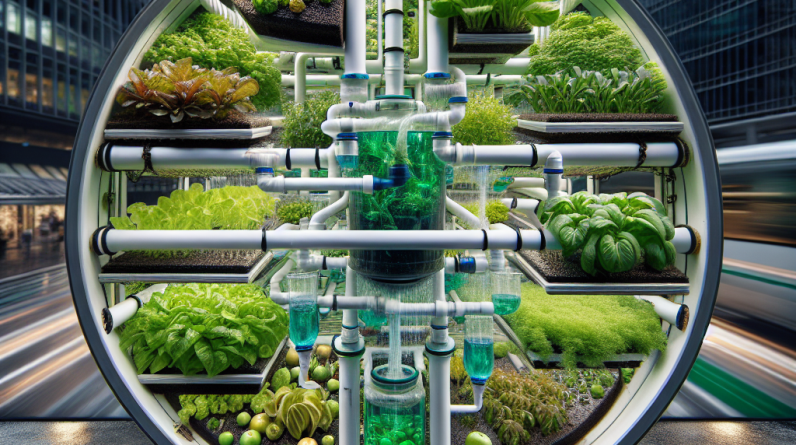
Water Conservation
Reduces Water Usage
One of the coolest benefits of recirculating hydroponic systems is how much water we can save. Traditional farming methods can waste a lot of water through evaporation and runoff. But in a recirculating system, the water is continually cycled through the plants and back to the reservoir. This means we’re using way less water overall.
In my own experience, I noticed that even in a small backyard setup, the amount of water I needed was drastically lower compared to conventional gardening. It’s actually quite impressive to see how much water is recycled, and it’s a huge win for the environment!
Moreover, the rainwater collection can be effortlessly integrated into these systems. Just think about it – using rain to nourish your plants while saving nectar from your water bill. It’s a win-win!
Better Nutrient Absorption
Another fantastic perk of recirculating hydroponic systems is the more efficient use of nutrients. In traditional soil gardening, nutrients can leach away or become unavailable to plants. But in a hydroponic setup, the nutrient solution circulates directly to the root zone. This allows plants to absorb nutrients more effectively.
From my own experience, I’ve seen how quickly plants respond to nutrient-rich solutions when they’re fed properly. They grow faster and are healthier, which can make any gardener pretty happy! Plus, I avoid the headache of guessing how much fertilizer is needed. I just mix the solution and watch my greens thrive.
With proper monitoring, you can tweak the nutrient levels based on what your plants need. Relying on a recirculating system means you’re always one step ahead, maximizing growth potential.
Less Chemical Usage
Since recirculating systems are so efficient at delivering nutrients and water, there’s less need for pesticides and herbicides. This is especially important for those of us who want to garden sustainably. The closed-loop nature of these systems often results in healthier plants that are less susceptible to pests.
From personal experience, I’ve found that the need for chemical interventions has drastically decreased since switching to hydroponics. This not only gives me peace of mind but also makes for healthier eating. You truly can grow organic, homegrown goodies without relying on harsh chemicals.
Let’s be real; who doesn’t want to munch on veggies that are as pure as possible? Thus, as a hobbyist gardener, I feel like I’m doing my part for the planet, and that’s definitely rewarding!
Space Efficiency
Ideal for Urban Gardening
Living in the city can make gardening tricky. There’s often not enough space for a traditional garden, but recirculating hydroponic systems are perfect for tight quarters! I’ve had great success growing food in small areas, even on balconies or rooftops.
The vertical gardening aspect of many hydroponic systems really maximizes the available space. I have a small setup where I can stack plants vertically, which has not only saved space but also added a bit of greenery to my concrete jungle!
Even if you’re tight on space, don’t let that stop you from growing your own food. Trust me, a recirculating hydroponic system can fit almost anywhere and transform your environment into a mini farm.
High Yield Potential
Let me tell you, if you’re looking for a garden that really delivers, recirculating hydroponic systems are known for their high yield potential. With the ability to control all the variables — light, nutrient levels, and water — you can grow plants to their maximum potential.
In my adventures with hydroponics, I’ve seen gorgeous produce and herbs that are not only plentiful but also delicious. The consistent environment allows plants to flourish, often doubling the output compared to traditional farming methods.
Plus, thanks to the shorter growth cycles that these systems afford, you’ll be reaping the rewards of your hard work sooner than you might expect. It feels like every time I eat something I’ve grown, there’s an extra dose of satisfaction mixed in with every bite!
Reduced Labor and Maintenance
Managing a traditional garden can be labor-intensive — think weeding, watering, and all that jazz. But with recirculating hydroponic systems, maintenance is pretty chill. Most of the hard work is minimized thanks to automation and the streamlined nature of how these systems operate.
I’ve set up timers and nutrient dosing systems that make sure I’m not running out there every hour to check on my plants. That means I get to enjoy my garden without it consuming all my free time!
Sure, some initial setup may take time, but once it’s running, you’ll wonder why you didn’t make the switch sooner. It’s one of those “why didn’t I think of this before?” moments that truly revolutionizes your gardening experience.
FAQ
What is a recirculating hydroponic system?
A recirculating hydroponic system is a method of growing plants without soil, where the nutrient-rich water is continuously cycled through the root zone of the plants. This helps to conserve water and ensures that plants receive consistent nutrients.
How much water can I save with recirculating hydroponics?
Water savings can be significant, sometimes reducing consumption by up to 90% compared to traditional gardening methods, depending on the setup and crops being grown.
Do I need to use chemicals with hydroponics?
While some systems can still use chemicals, recirculating hydroponic systems allow you to grow without reliance on pesticides and herbicides, especially since healthy plants are generally less susceptible to pests.
Can I grow hydroponically in a small space?
Absolutely! Recirculating hydroponic systems are perfect for urban gardening and can easily fit into small spaces, such as balconies or even indoors.
What types of plants can be grown in a recirculating hydroponic system?
Virtually any plant can be grown in these systems, but leafy greens, herbs, and small fruiting plants like strawberries are particularly popular due to their fast growth rates and high yield potential.







